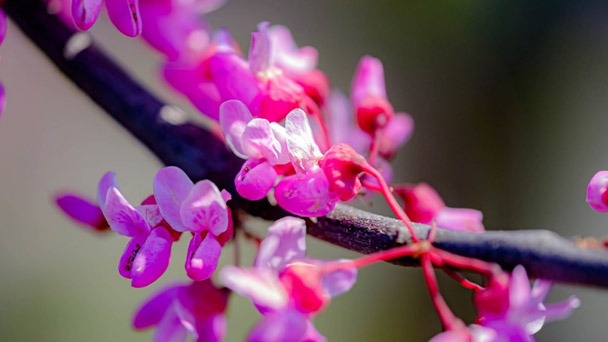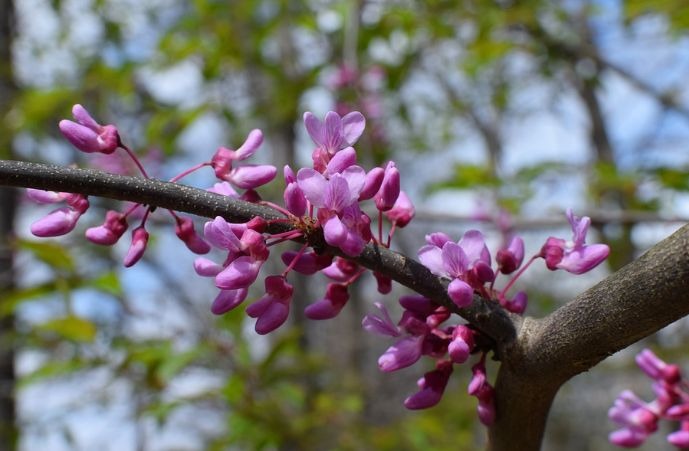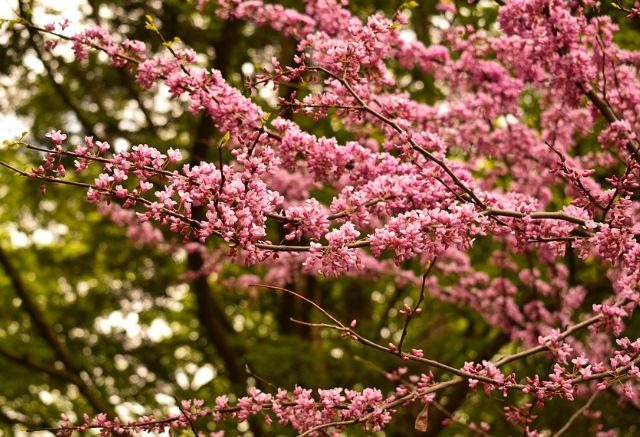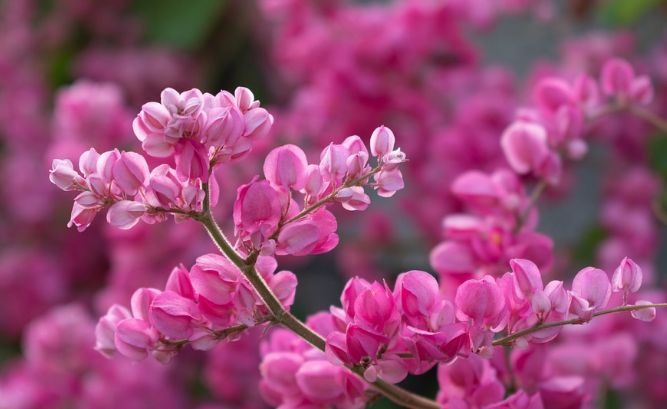Pros and Cons of Redbud Trees - What You May Not Know
Written by Ivy
Jan 10 2023

One of the most exquisite native trees to grace the continent of North America is undoubtedly the Eastern Redbud. This tree is attractive, beneficial to wildlife, and won't grow too big, making it a great landscaping tree to grow close to your house.
The benefits and drawbacks of redbud trees are as follows. Let's find out now.
Quick Look: Pros and Cons of Redbud Trees
Pros:
- Very Low Maintenance
- Beautiful natural touch
- Drought tolerance
- Small in size
- Flowers bloom for a long time
Cons
- Grow once a year
- Require far too much water
- Short lifespan
- Bugs to avoid
- Only bloom in the spring
Redbud Tree Facts

Native to all of North America, redbud trees make excellent ornamental plants. The flowers provide color all year long without the need for constant pruning and draw pollinators like bees or butterflies. Although they can tolerate some shade if necessary, they grow best in direct sunlight.
These tiny flowering trees prefer soil that is rich in organic matter, such as compost, manure, etc., which means adding some fertilizer every few months would keep the tree healthy. This plant produces thousands of tiny pinkish flowers all spring long, adding beauty to your landscape.
Pros of Redbud Trees
By providing shade and a magenta tint, they add beauty to your garden or backyard. These trees draw pollinators in addition to improving the ecology. The fact that you won't need to spend time on tree or soil maintenance every week or month is one of the main benefits of redbud trees.
1. Very Low Maintenance
Judas or redbud trees require little maintenance. Even when the temperature drops to -5°F (-15°C), they can survive and frequently even thrive in a variety of soil and climatic conditions.
The tree will grow well in either full sun or partial shade, though it does prefer full sun for a really good flower display. The tree does have a strong preference — even a need — for chalky or limestone soils (meaning soils that are alkaline and not acidic).
2. Beautiful Natural Touch
Smaller plants with flowers that bloom before the tree are beautifully framed by the tiny flowers, which add magenta tones to the scene. Additionally, they offer some year-round coverage without displacing other plants in your landscape design.
During the autumn months, the lovely heart-shaped leaves turn a brilliant yellow/orange color. No matter what time of year you plant them, redbuds are an excellent way to add color to any landscape.
3. Drought Tolerance
They are excellent for Xeriscaping because of their high drought tolerance. The plant continues to grow throughout the spring before ceasing for the rest of the year.
4. Small in Size
They are perfect for planting in small spaces where larger shade trees wouldn't fit due to their diminutive size and form, such as beneath power lines. One of the most prominent advantages of redbud trees is that they will not
read wires or power lines above them.
5. Flowers Bloom for a Long Time
Early in the year and into the fall, redbud trees continue to bloom. Their peak flowering period typically lasts from April to May, but depending on how hot the summer is, their blooms may last until June or even July.
Cons of Redbud Trees
It is preferable to have the tree in the spring because it is leafless in the fall. It follows that you should be ready to maintain and clean it. There are a number of additional drawbacks to redbud trees.
1. Grow Once a Year
Redbud trees have a number of drawbacks, including the fact that they can only grow once per season, which draws insects that eat plants. Your tree probably won't bloom again until the following growing season if it doesn't bloom between February and May. Be prepared to perform your maintenance, which could take some time.
2. Require Far Too Much Water
Water is a big issue for redbuds, especially in the first year when they are just getting started. Providing them with plenty of fresh, clean water on a regular basis will help keep them healthy if you decide to plant them.
3. Short Lifespan
Redbud trees only live 20 to 30 years. Therefore, if you're looking for a long-term investment, this might not be the right tree for you. However, they do produce color annually for the remainder of their lives, making them perfect for use as accent plants or in smaller settings where more massive shade trees would be too big.
4. Bugs to Avoid
The leaves of redbuds can be eaten by insects or animals if they don't get enough water, despite the fact that they are typically disease- and pest-resistant. If your tree appears sickly, with yellowing leaves, likely, it is not getting enough
water. In addition, they draw insects like aphids, which can be bothersome, especially for those who are allergic to them.
5. They Only Bloom in the Spring
Redbuds typically only bloom once each growing season, unless you live at the southernmost point of their range, in which case, with enough water, they might bloom twice. Blossoming might not start until the end of winter.
Redbud Leaf Spot Diseases
Unappealing redbud leaf spots can be produced by fungi like Phyllosticta, Cercospora, and Gloeosporium species. Symptoms typically manifest themselves during hot, humid weather spells. The foliage develops irregular, discolored spots. The spots might disappear, leaving the foliage with holes. The tree may lose leaves that are seriously ill. Fungicides are typically not advised because leaf spot diseases rarely cause harm to redbuds.
Your redbud tree can avoid contracting ailments and fungus if you keep it robust and healthy. Act quickly to stop the spread of the disease and avert severe injury or death to the tree if you spot symptoms of these ailments.
Identification and Characteristics of Eastern Redbud Tree

As a general rule Eastern Rebud Trees grow 12-30′ tall with a short trunk but an irregular, wide-spreading canopy / crown. It frequently has multiple trunks or stems.
However, a tree that grows in complete shade may have an arched, long, thin trunk. As long as a larger nearby tree doesn't fall and block off a new window of sunlight, these shade-loving Redbuds will continue to develop in that manner.
Trunk / Bark
Redbud trees have rough, gray bark that has small furrows and scales on it. The bark of young trees and branches is smooth and gray, and new growth (twigs) is typically reddish brown.
Redbud trees have many branches, and they frequently overlap one another while weaving through other branches. Therefore, it is a good idea to prune the crossing branches every other year in late winter or early spring.
Eastern Redbud Leaves
The alternating, heart-shaped (cordate), and 2-5″ long by the same width leaves of the eastern redbud have smooth margins. The leaves have no hair.
A leaf's upper side is a medium green, and its underside is a paler green.
Redbud Leaves in Autumn
Autumn brings out the golden yellow color in the Eastern Redbud Tree's leaves, which eventually turn brown in the winter. The Eastern Redbud Tree's fall foliage is quite lovely because it adds a lovely yellow "pop" to the landscape.
Flower
Mid-Spring is when Redbud Trees begin to bloom. According to research, trees in some regions require 30 days of average daily temperatures outside of 50F (10C) or higher.
Before the leaves emerge in the spring, tiny clusters of pink-white flowers develop along the trunk's bark and older branches. In the bud stage, there are initially no stems, but eventually, tiny petioles will grow to be about 3/4" long.
In the middle of spring, redbuds typically bloom for four weeks. The blooming happens in clusters of two to eight individual flowers, and the color changes from "hot-pink" (the bud stage) to "light-pink" (the open stage). Flowers are pea-shaped, half an inch long (12 mm), and have five petals.
Eastern Redbud Tree Seed Pods
Following flowering, seeds-containing pods will develop. These seeds take a very long time to form, and the pods won't be ready until late summer or early fall.
The pods measure 2-5 inches long by 1/2 inches wide and have 3-10 seeds inside. Small, flat, hard, and oval-shaped seeds measuring 3 mm by 5 mm have a thickness of 2 to 3 mm. Comparable to bean seeds is the seed.
How Eastern Redbud Trees Spread
Eastern Redbud trees proliferate through seed. Wild animals (birds, squirrels) tend to scatter the majority of their seed close to the mother tree. Because they have a tough shell on the outside, seeds that fall to the ground frequently dormant for a year or two.
Related – If one wants to go foraging for Eastern Redbud Seeds in the wild, then I suggest you have a look at my detailed guide.
Root System
The Eastern Redbud tree's root system consists of lateral, shallow roots. They usually grow past the crown and are typically found in the top six inches of the soil. See my image below to see what the Redbud Tree's root system looks like. This was on a tree that was three years old that I had moved and transplanted a few years earlier.
The exciting part will now follow. Redbuds have a taproot, according to two reliable sources, but when there is "impenetrable soil," the taproot expands horizontally. Well, when I moved a 3-year-old Redbud tree, I discovered a ton of lateral roots pointing in different directions, but no taproot! I don't think I can give you a good answer, because my experience tells me there isn't a taproot, so who is right?
Eastern Redbud Throughout the Seasons
The tree's eye-catching pink flowers will bloom in the spring. After the bloom, the heart-shaped (cordate) leaves will grow, and it will look like a typical deciduous tree (with the addition of seed pods). And finally, the autumn leaves turn a brilliant yellow for a lovely display.
As a deciduous tree, the Eastern Redbud eventually loses its leaves in the fall.
The Eastern Redbud's appearance in the three seasons of spring, summer, and fall are depicted in the infographic below.
Conclusion
Redbud shrubs are a great way to beautify your garden or backyard, provided you're ready to deal with any issues that may come up. Only in the spring can it enliven the surroundings. For the remainder of the year, you should invest more time in it. You can undoubtedly decide what needs to be done to address the issues by considering the benefits and drawbacks of growing redbud trees.

Some Frequently Asked Questions About Redbud Trees
1. Do Redbud Trees Make a Mess?
Redbud trees can be positioned up to 8 feet from the house and are hardy, shade-tolerant, and attractive blooming shrubs. They have tasty fruit as well as fragrant blossoms! Although they aren't particularly messy, they do shed seed pods. Pruning can be done at any time during the blooming season.
2. What is the Ideal Spot for a Redbud Tree?
It's crucial to maintain a moist, well-drained soil. Alkaline and acidic soils are just two of the many soil types where redbuds can grow. To prevent the emergence of fungal infections, place redbud trees in an area with good airflow.
3. Is It True That Redbud Trees Develop Invasive Roots?
After being planted, trees can withstand numerous droughts. On the other hand, trees that have been around for a while need less water because their taproots are stronger. Redbuds, for instance, have shallow roots overall and a deep taproot.
4. What is a Redbud Tree's Life Expectancy?
Redbud trees have a lifespan of 50 to 70 years when they are in good health. On the other hand, cancer of the trunk and wilt brought on by fungi can drastically reduce their lifespan.
5. In the Summer, How Does a Redbud Tree Look?
Autumn leaves are yellowish, while summer leaves are dark green. The pea-like flowers have a purple undertone and are rosy pink. The ramiflorous redbud produces flowers and fruit on bare twigs. This is a distinctive quality of temperate-zone trees.
Latest Updated
- Benefits of Bugleweed - 7 Science-backed Health Benefits
- Bugleweed Dangers & Side Effects - Is It Poisonous?
- How to Plant Evergreen Trees - What You Should Know
- When to Plant Evergreens - Grow Guide for Evergreen Trees
- 12 Wonderful Evergreen Shrubs for Your Garden
- 12 Popular Evergreen Plants with Pictures for Beginners
- When And How To Prune A Lilac Bush Like a Pro
- How to Grow & Care for Lilac Vine (Hardenbergia Violacea)
- Japanese Lilac Tree (Syringa Reticulata) Care & Propagation Guide
- Shumard Oak Pros and Cons - What to Know
Popular Articles
- Winter maintenance of Antirrhinum Majus
- How to Grow Terminalia Mantaly Tree
- How to Grow and Care for Crossostephium Chinense
- How to grow Antirrhinum Majus in spring
- Peristeria Elata (Dove Orchid) Profile: Info & Care Guide
- Underwatered Snake Plant (Sansevieria Trifasciata) - Signs And How To Fix
- How to Care for Brazilian Jasmine Plant (Mandevilla Sanderi)
- How to Grow & Care for Graptopetalum Purple Delight in Summer
- Rosa Chinensis (China Rose): Plant Growing & Care Tips
- How to Care for Baby Sun Rose (Aptenia Cordifolia)